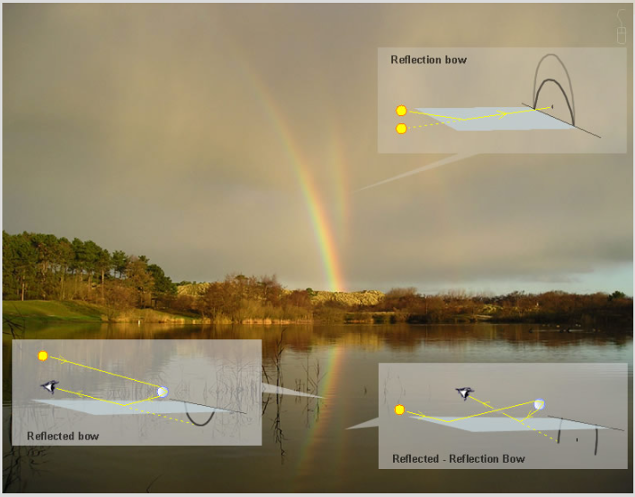Reflection and reflected bows Terschelling, The Netherlands
Reflection and Reflected Bows: A Mesmerizing Atmospheric Phenomenon in Terschelling, The Netherlands
The captivating world of atmospheric optics never fails to surprise us with its stunning displays of light and color. One such spectacle is the occurrence of reflection and reflected bows, which can be witnessed in the picturesque Dutch Frisian Island of Terschelling. On a tranquil morning in December 2006, photographer Gerrit Doeksen captured this extraordinary event, showcasing primary, reflection primary, and secondary bows above the horizon. However, what truly sets this phenomenon apart are the arcs below the horizon – the reflected bow and the reflected reflection bow – formed from distinct raindrops.
When we gaze upon the sky during a rain shower, we often observe the familiar sight of a primary rainbow arcing across the heavens. This celestial phenomenon occurs when sunlight interacts with raindrops, causing the light to refract, reflect, and disperse. But there is more to the story than meets the eye. The reflection and reflected bows that appeared on that enchanting morning in Terschelling unveil the intricate nature of light and water droplets.
The primary bow is a result of sunlight entering a raindrop, refracting upon entry, reflecting off the inner surface, and finally refracting again upon exit. It forms an arc of vibrant colors, with red on the outer edge and violet on the inner edge. Above the primary bow lies the reflection primary bow, which occurs when sunlight reflects twice within the raindrop before exiting. This reflection causes the colors to appear in reverse order compared to the primary bow.
As we venture below the horizon, we encounter two mesmerizing phenomena that are not mere reflections of their celestial counterparts. The first is the reflected bow, which occurs when sunlight reflects off a water surface and then interacts with raindrops suspended in the air. This creates a secondary arc of colors below the horizon, mirroring the primary bow. The second phenomenon is the reflected reflection bow, where sunlight reflects off the water surface, reflects again off the raindrop, and then interacts with a second water surface before reaching our eyes. This results in a third arc of colors below the reflected bow.
To fully appreciate the beauty of these atmospheric optics phenomena, it is crucial to understand the science behind them. Rainbows, whether primary or reflected, are intricately linked to the refraction and reflection of light. As sunlight passes through raindrops, it undergoes a process known as dispersion, where the different wavelengths of light separate, creating the vibrant colors we see. The angle at which the light enters and exits the raindrop determines the size and shape of the rainbow.
It is worth noting that the size and intensity of reflection and reflected bows can vary depending on several factors. The position of the sun in relation to the observer, the angle at which sunlight strikes the raindrops, and the size and shape of the raindrops all play a role in shaping these ethereal phenomena. Additionally, atmospheric conditions such as the presence of other particles in the air can further influence the appearance of reflection and reflected bows.
The occurrence of reflection and reflected bows serves as a reminder of the hidden wonders that exist within our natural surroundings. These captivating displays of light and color provide us with a glimpse into the intricate interplay between sunlight, water droplets, and our atmosphere. As we marvel at these atmospheric optics phenomena, let us embrace the sheer beauty and complexity of our world, where even the simplest rain shower can reveal a symphony of colors dancing across the sky.
In conclusion, the reflection and reflected bows witnessed in Terschelling, The Netherlands, offer a breathtaking display of atmospheric optics. From the primary and reflection primary bows above the horizon to the reflected bow and reflected reflection bow below, each phenomenon unveils the intricate interaction between sunlight and raindrops. By understanding the science behind these phenomena and appreciating the factors that influence their appearance, we can truly appreciate the awe-inspiring beauty of our natural world. So, next time you find yourself in the midst of a rain shower, take a moment to look up and witness the mesmerizing dance of reflection and reflected bows in the sky.


Reflected and reflection rainbows
Imaged by Gerrit Doeksen at the Dutch Frisian Island of Terschelling on the morning of 18th December 2006, solar elevation ~4°. Image ©Gerrit Doeksen.
Above the horizon are primary, reflection primary and secondary bows.
The arcs below the horizon are not straightforward reflections of the sky bows but are formed from different raindrops. They are a reflected bow and a reflected reflection bow.
Mouse over the image for details. More reflected & reflection bows 1,2,3,4.
Note: this article has been automatically converted from the old site and may not appear as intended. You can find the original article here.
Reference Atmospheric Optics
If you use any of the definitions, information, or data presented on Atmospheric Optics, please copy the link or reference below to properly credit us as the reference source. Thank you!
-
<a href="https://atoptics.co.uk/blog/reflection-and-reflected-bows-terschelling-the-netherlands/">Reflection and reflected bows Terschelling, The Netherlands</a>
-
"Reflection and reflected bows Terschelling, The Netherlands". Atmospheric Optics. Accessed on November 22, 2024. https://atoptics.co.uk/blog/reflection-and-reflected-bows-terschelling-the-netherlands/.
-
"Reflection and reflected bows Terschelling, The Netherlands". Atmospheric Optics, https://atoptics.co.uk/blog/reflection-and-reflected-bows-terschelling-the-netherlands/. Accessed 22 November, 2024
-
Reflection and reflected bows Terschelling, The Netherlands. Atmospheric Optics. Retrieved from https://atoptics.co.uk/blog/reflection-and-reflected-bows-terschelling-the-netherlands/.